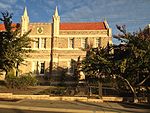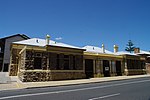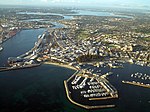St Patrick's Basilica, Fremantle
1900 establishments in Australia20th-century Roman Catholic church buildings in AustraliaBasilica churches in AustraliaChurches in FremantleDonnybrook stone buildings ... and 4 more
Roman Catholic churches completed in 1900Roman Catholic churches in Western AustraliaState Register of Heritage Places in the City of FremantleUse Australian English from May 2013

Basilica of St Patrick is a Roman Catholic church located on Adelaide Street in Fremantle, Western Australia. It is one of five churches in Australia with minor basilica status.
Excerpt from the Wikipedia article St Patrick's Basilica, Fremantle (License: CC BY-SA 3.0, Authors, Images).St Patrick's Basilica, Fremantle
Adelaide Street,
Geographical coordinates (GPS) Address External links Nearby Places Show on map
Geographical coordinates (GPS)
| Latitude | Longitude |
|---|---|
| N -32.0509 ° | E 115.75 ° |
Address
St Patrick's Basilica
Adelaide Street
6959
Western Australia, Australia
Open on Google Maps










